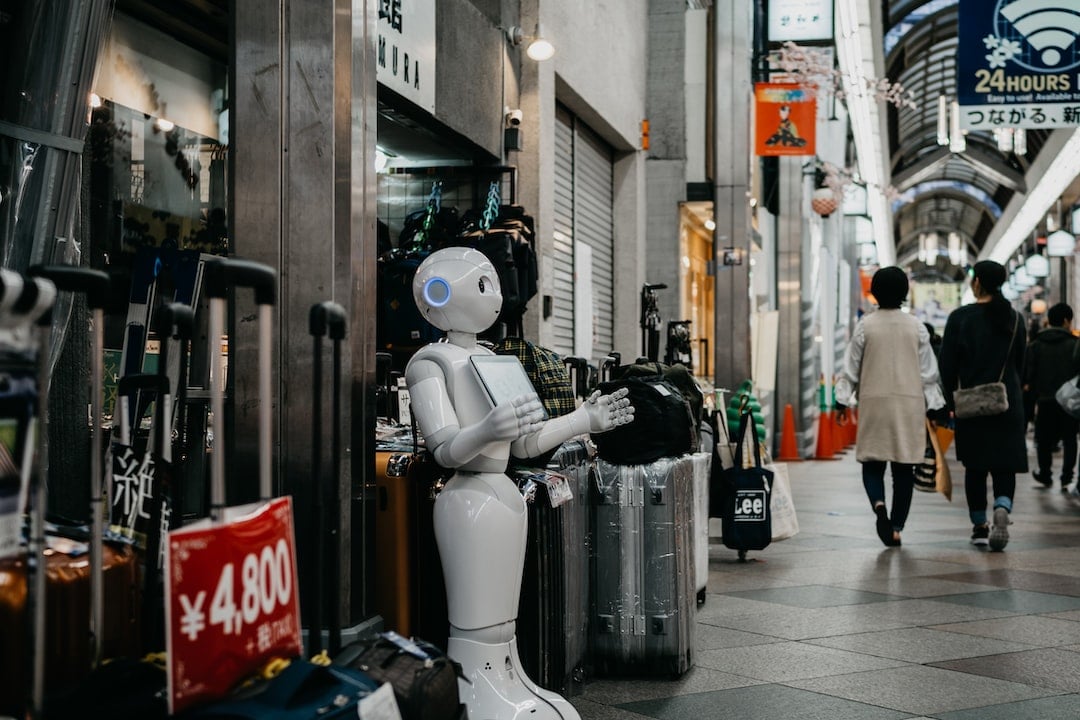The Power of AI in Graphic Design: An In-Depth Guide for Beginners

The rapid advancement of technology is powering transformative applications across various fields, and graphic design is no exception. Designers around the globe are harnessing technologies such as artificial intelligence (AI) to increase efficiency, ignite creativity and customize user experiences.
Definition of artificial intelligence (AI) in graphic design
In graphic design, artificial intelligence applies the capabilities of machines and software to imitate intelligent human behavior and solve complex design problems. This sophisticated tech insinuates itself into design processes, enabling software like Adobe's Sensei, Canvas graphic design tools, and Figma, among others, to automate routine tasks, generate design options, and learn from user input.
Importance of AI in revolutionizing graphic design for beginners
The value of AI for beginners in graphic design must be balanced. Here are a few reasons why:
- AI reduces the steep learning curve typically associated with mastering graphic design software. Beginners can rely on AI-enabled design tools to handle complex tasks, allowing them to focus on the creative aspects of their projects.
- It democratizes design by making professional-grade tools accessible to a broader audience. No longer is high-quality design reserved for experts with years of training; AI technology breaks down barriers and opens up opportunities for newcomers.
- AI can offer inspiration by suggesting design elements based on trends, user behavior, and aesthetics, fueling creativity and innovation for beginners.
In essence, artificial intelligence is revolutionizing graphic design, redefining how beginners approach, learn, and flourish.
Understanding AI in Graphic Design
The intersection of technology and artistry, specifically in graphic design, paints a thrilling picture. The natural marvel in this scenario is Artificial Intelligence, emerging as a potent tool to enhance, streamline, and optimize the creative process, particularly for novices.
Explanation of how AI algorithms work in graphic design
AI functions by utilizing machine learning and advanced algorithms that recognize, learn, and execute design patterns and techniques. The magic behind AI algorithms in graphic design is their ability to analyze trillions of data pieces and learn from them to create something new.
- They can discern comparable aspects from thousands of images, comprehending the traits shared among recognized good designs.
- AI can replicate similar design components for novel creations, thus saving time while maintaining quality.
- Algorithms assist in predicting what designs will resonate with specific demographic segments, thereby permitting targeted and practical designs.
Overview of AI-powered tools and software used in graphic design
AI has been incorporated into tools and software that impact every level of design, from conceptualization to execution.
- One widely recognized platform is Figma, a cloud-based design tool known for its powerful collaborative features. Figma's AI-powered auto-layout functions allow beginners to execute complex design operations easily.
- Adobe Sensei, Adobe's AI and machine learning platform, is another tool that leverages AI to amplify designers' creativity. It can analyze an image and suggest style changes, making it an invaluable tool for beginners.
Employing AI in graphic design doesn't stifle creativity but instead encourages it. It's about working smarter and efficiently, letting creative juices flow more readily. I'd like you to stay tuned for how you can weave this transformative power into your design journey.
Benefits of AI in Graphic Design for Beginners
AI has brought about a profound transformation in virtually all sectors, and the world of graphic design is no exception. Particularly for beginners, utilizing AI technology in graphic design promises manifold benefits. Let's examine a few of them.
Time-saving capabilities of AI tools in graphic design
One big advantage of AI in graphic design is its significant time savings. Traditional methods of graphic designing could be immensely time-consuming, especially for novices finding their way into the complex world of design work.
- Automated elements: Tools like Figma, powered by AI, offer beginners automated design features like auto layout, responsive resizing, and automatic grid generation, sparing you the tedious manual work.
- Quick modifications: AI enables swift changes in design elements, like colors or shapes, without manually adjusting each item.
- Speedy processing: AI-based applications can handle large quantities of data in seconds, a feat impossible for humans.
Enhancing creativity and productivity with AI assistance
Artificial intelligence is also a potent catalyst for sparking creativity and improving productivity among graphic designers. AI can help beginners by:
- Offering design suggestions: AI can provide various design suggestions based on the user's previous work or trending design concepts.
- Prompting innovative thinking: AI's capabilities can inspire designers to think outside the box and explore new design vistas.
Simplifying complex graphic design tasks for beginners
Graphic design is no cakewalk. However, AI simplifies complicated tasks, making the design process more approachable for beginners.
- Easy Navigation: Tools embedded with AI technology assist beginners in navigating through design tasks. They offer an intuitive interface that allows users to understand its functionality easily.
- Design Revision: AI algorithms improve the accuracy of design revisions, rectifying even the minutest errors that a human eye might miss.
In conclusion, AI is revolutionizing the graphic design arena, making it more accessible and friendlier to beginners. The perfect fusion of creativity and technology ensures that even those new to the game can produce stunning, professional-grade designs.
AI-Driven Design Trends for Beginners
Artificial Intelligence has become a game-changer in various sectors, and graphic design is no exception. Whether you are just getting started or are heavily involved in the design world, this revolutionary technology offers a new and exciting way to hone your skills and expand your creativity.
Exploration of AI-generated design trends in graphic design
One of the most striking AI-driven trends is the power of automated graphic design. Today, AI systems such as Figma's Auto Layout allow beginners to design with less manual work. The system offers various functionalities such as:
- Adjusting design layouts automatically according to the content input.
- Seamless resizing and reorganization of design elements.
- Offering pre-designed templates that are customizable through drag-and-drop.
Examples and case studies of successful AI-driven graphic design projects
There is a multitude of successful AI-designed projects out there. One notable example is Nutella's 'Unique' campaign, where their design team created 7 million unique jar designs in less than a month using an algorithm. And AI isn't limited to extensive corporate campaigns, either. Many beginners have successfully leveraged AI technology to develop compelling visual content, even for more straightforward projects like designing social media graphics or digital advertisements.
Overall, the rise of AI in design is a trend that will only grow. With AI tools increasingly becoming accessible to beginners, the future for budding graphic designers is bright and full of creative potential.
AI in User Experience (UX) Design for Beginners
The rapid growth in artificial intelligence (AI) has had a profound impact on many sectors, with graphic design being no exception. For beginners in the field, understanding the connection between AI and User Experience (UX) design can unlock new avenues of creativity and efficiency.
Introduction to AI-driven UX design and its impact on user engagement
In essence, AI-driven UX design utilizes artificial intelligence's algorithms and processing power to create more intuitive and engaging user interfaces. The beauty of AI in UX design lies in its ability to understand and anticipate end-user needs, thereby allowing for more personalized and seamless experiences. It analyzes heaps of user data to discern patterns and behaviors. This results in designs that look appealing and significantly enhance user engagement and satisfaction.
Techniques and tools to incorporate AI in UX design for beginners
For beginners looking to harness the power of AI in their UX designs, the plethora of techniques and tools available might feel overwhelming. However, adopting AI into your design process doesn't necessarily require coding skills or a deep understanding of advanced algorithms. Software like Figma, for instance, is leveraging AI to aid in automatic layout adjustments and even font pairing, a task traditionally reliant on a designer’s aesthetic judgment. Some other ways to incorporate AI into UX design include:
- Using AI chatbots in UX design for personalized customer interaction
- Implementing AI-powered analytics to evaluate user behavior
- Utilizing predictive design systems to anticipate user needs
Jumping into the world of AI might seem intimidating at first, but with the right tools and high-level understanding, AI can supercharge your creativity and take your UX designs to the next level.
AI-Driven Collaboration in Graphic Design for Beginners
The world of graphic design is fast becoming a dynamic sphere, mainly due to the decisive input of Artificial Intelligence (AI). A beginner in the graphic design field no longer needs to brace for the steep career learning curve. Welcome to the age of AI-driven collaboration!
Digital collaboration tools powered by AI for remote graphic design teams
Graphic design presents a world of visual communication and problem-solving. AI is changing the game for beginners, making digital collaboration more accessible and productive. Figma, an interface design application that facilitates design collaborations, is notable among these tools. With its AI functioning, Figma allows real-time collaboration, making it possible to co-design, share, examine, and amend a design across a team, regardless of location and time differences.
Benefits and challenges of AI-driven collaboration in graphic design
Admittedly, integrating AI in graphic design has its benefits and independent challenges:
- Benefit: For one, AI makes graphic design more efficient. You can prototype faster, iterate ideas quickly, and keep up with trending designs.
- Challenge: As exciting as AI is, there is a potential for creativity to be stifled. There is the fear that AI might replace the human's creative stylishness, reducing the craft to cold, calculated geometry.
Ultimately, while we acknowledge these concerns, it's clear that AI is here to stay. The onus lies on us to leverage these technologies while continually fueling our human creativity to remain relevant in the dynamically evolving world of graphic design.
AI and Creativity in Graphic Design for Beginners
The image of graphic design is continually reshaped and redefined by the unstoppable march of technology, particularly with the advent of artificial intelligence (AI). Let's get down to the nitty-gritty and explore AI's immense possibilities for beginners in graphic design.
Discussion on the role of AI in sparking creativity for beginners
AI tools and applications, such as Figma, are no longer optional extras but are fast becoming indispensable components of a designer's arsenal. Their role in ensuring efficiency and accuracy is undeniable, but they also hold the key to fostering creativity, especially for beginners. Here's how:
- AI can automate time-consuming, repetitive tasks. This streamlining leaves designers free to devote more time to the creative aspects of their work.
- AI-powered software can analyze and interpret data faster and more accurately than humans. This capability allows designers to glean insights, identify patterns, and create more impactful, personalized designs.
- The advanced algorithms underlying AI can enable beginners to bypass some of the technical barriers, helping them bring their ideas to life more effortlessly.
How AI can be used as a source of inspiration and innovation in graphic design
The predictive capability of AI, powered by machine learning, can fuel creativity like nothing else. AI tools can suggest design options, color palettes, and layouts based on emerging trends, popular styles, or a brand's prior designs. This saves time and can serve as a vast source of inspiration, providing a springboard for beginners to leap from while exploring their creative potential. AI challenges and pushes the boundaries of traditional design, encouraging innovation and paving the way for beginners to create unique, modern designs.
Overcoming Challenges with AI in Graphic Design for Beginners
Integrating AI into your creative process can be exciting and challenging for a beginner in graphic design. The ability of AI to streamline design tasks, experiment with infinite design combinations, and make improvements based on data patterns opens up a world of possibilities. However, there are common concerns that beginners often encounter.
Addressing concerns about AI replacing human creativity in graphic design
One primary concern is the notion that AI might replace human creativity. However, AI should be viewed not as a substitute but as a tool that enhances human creativity. Here's how:
- AI removes mundane tasks: AI can automate repetitive tasks, allowing designers more time to conceptualize and brainstorm ideas.
- AI provides data-driven insights: AI can analyze data trends to give recommendations that can spark new creative ideas.
- AI opens avenues for experimentation: With AI, you can effortlessly explore different designs, colors, and layouts, offering limitless opportunities to experiment.
Strategies to embrace AI while preserving personal artistic expression
While AI has much to offer, preserving personal artistic expression is essential. Here are some strategies to embrace without compromising creativity:
- Use AI as a creative partner: AI can assist in generating initial ideas that can be fine-tuned to reflect your style.
- Adapt and learn: As AI tools evolve, so should your skillset. Platforms like Figma offer AI tools tailored for beginners. You can use these to enhance your technical abilities while cultivating your unique artistic voice.
- Maintain design ethics: While AI can aid design, remember to uphold design principles and ethics. Never compromise on authenticity, originality, and user-centered design, no matter how advanced the technology is.
In essence, think of AI as your creative collaborator, not competition. Embrace the power of AI, but never let it overpower the human touch that makes graphic design so impactful.
Future of AI in Graphic Design for Beginners
The trajectory of AI in Graphic Design, especially for beginners, has immense potential. This wonder of technology is transforming how we visualize and create designs, making it a promising aspect to delve into.
Predictions and Possibilities of AI Advancements in Graphic Design
What is the future for AI in Graphic Design, particularly for novices?
- Advanced Personalization: AI could empower design to become more personalized than ever. Understanding user preferences in real time could modify designs for better user engagement.
- Automation of Basic Tasks: AI might automate mundane tasks, allowing designers to explore their creativity on more critical parts of projects.
- Lending a helping hand in research: AI might be able to scour through the vast expanse of the internet, digging out inspirational design ideas based on user preferences.
Ethical Considerations and Potential Limitations of AI in Graphic Design
With AI's growth in graphic design, a few ethical considerations and limitations appear on the radar.
- Job replacement: While AI enhances productivity, there are concerns about AI usurping human jobs in the design sector.
- Diminishing creativity: AI can mimic patterns and create designs, but there's a fear it could reduce the creative originality traditionally attributed to human designers.
- Ethical use of data: AI relies heavily on data. Ethical issues can arise regarding how this data is collected, used, and stored.
While AI harbors splendid potential for graphic design, these questions about its limitations and ethical implications are vital for any beginner to ponder.
Conclusion
Recap of the transformative power of AI in graphic design for beginners
As we've seen, the advent of AI has brought about a significant revolution in graphic design, especially for beginners. This innovative technology has simplified a plethora of traditionally complex and time-consuming tasks. AI tools like Figma have proved to be game-changers, from auto-generating designs to providing color palette suggestions. They intuitively adapt to user behaviors and preferences, allowing for more personalized and efficient design experiences. Moreover, AI encourages beginners to learn and practice graphic design by producing instant and stunning visuals.
Encouragement for beginners to leverage AI to enhance their creativity and skills
If you're a beginner in graphic design, don't hesitate to incorporate AI into your workflow. It will amplify your creativity and provide invaluable insights to comprehend design principles better. Here are some ways to do it:
- Utilize AI-based software such as Figma for automated and personalized layout designs
- Apply intelligent color-matching systems to give your designs a professional touch
- Employ AI to generate unique font pairings that would otherwise require a keen eye and experience
- Use AI image enhancement tools to edit and perfect images without needing prior editing skills
AI is here to help you become a more productive and creative designer. Embrace the technology and let it empower your design journey.
You can modify and adapt the outline depending on your preferences and the content you intend to cover.
Remember, the primary intention of AI is to enhance human capability, not replace it. So, you can adjust, rethink, and mold it according to your individual needs and design goals. The AI tools are your loyal comrades; their ultimate purpose is to assist you in bringing out your real potential and creativity. So, unleash your imagination, trust the power of AI, and embark on your remarkable journey in graphic design.



